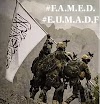Related by Abu Hurayrah ra: The Prophet Sallallahu 'Alaihi Wa Sallam said: "(Armies carrying) black flags will come from Khurasan (Afghanistan). No power will be able to stop them and they will finally reach Jerusalem where they will erect their flags." (Tirmidhi)
U.S. Has No Idea Who’s a Taliban ‘Leader,’ Still Boasts About Killing Them
Taliban
fighters line up to hand in their guns to the Afghan government during a
“reintegration” ceremony, May 2012. Photo: Flickr/ISAF
Since January 2011, the U.S.-led coalition in Afghanistan claims it’s killed or captured over 100 insurgent “leaders.” Too bad it doesn’t have any clear idea what “leader” means. Any insurgent who commands another person apparently qualifies. And worse, by that criteria, Taliban and aligned insurgents have killed twice as many U.S. troops in the same time period.
According to Danger Room’s count, since January 2011, ISAF troops have killed or captured at least 104 insurgent leaders. You might expect the insurgency to be battered from the loss of so many senior commanders in such a short period of time.
That’s the impression left from press release after press release. “A Taliban leader,” who happens to be an “explosives expert,” was taken into custody in Kandahar on July 8. Two days before, an airstrike killed “the Lashkar-e-Taiba insurgent leader Ammar” in Kunar Province. The day before that, the NATO command in Afghanistan, known as ISAF, killed “a senior Taliban leader,” Nek Mohammed, in the northern province of Sar-e Pul.
But what ISAF isn’t disclosing is that it doesn’t have any clear criteria for who it considers an insurgent leader. “The ISAF Joint Command does not have a specific definition for insurgent leaders in terms of geographical responsibility or numbers of men under command,” ISAF said in a statement provided to Danger Room. “In general, when we refer to an insurgent or terrorist leader, it is a member of an insurgent or terrorist organization who leads a number of insurgents in conducting attacks, facilitating attacks or coordinating the provision of support to permit the continuance of the insurgent or terrorist activities.”
“It depends a bit on the levels at which you’re taking the leadership down to,” adds U.K. Navy Lt. Cmdr. James Williams, an ISAF spokesman. “Any group of people have a leader, [whether there's] two or more, there’s always one of those people who’s in the lead.”
Danger Room tallied up ISAF’s announced kills and captures from the American Forces Press Service, the Pentagon’s official news service, which takes its information from ISAF. Permutations on “Taliban leader,” “Haqqani network leader” and “insurgent leader” stretching back to January 2011 counted for this sample. This total is surely incomplete, since not every ISAF announcement makes it into the American Forces Press Service.
Williams adds that ISAF would count the insurgent equivalent of a sergeant in charge of a squad of a handful of soldiers as a “leader.”
By that definition, the U.S. suffered twice as many casualties of “leaders” during that period. According to Danger Room’s count, 246 soldiers, Marines, sailors and airmen with the rank of sergeant or higher have been killed in Afghanistan since January 2011. The Taliban could just as easily boast of that figure to convey an adversary in disarray. But since the ISAF military structure remains robust, it would be a misleading claim.
Insurgencies are confusing things, and after 10 years of war, the U.S. still struggles to understand Afghanistan and the insurgency that feeds off it. The Taliban and affiliated groups have no clear order of battle. “If a person was considered a leader” in an ISAF press release, Williams says, “that would be based on a considered assessment, as opposed to [ISAF] trying to glorify a success.”
Some ISAF determinations of who is an insurgent leader are stronger than others. Operations that ISAF announces occur “to detain a Taliban leader” or other specifically named individual, Williams says, occur pursuant to a “warrant issued by the appropriate authorities,” often an Afghan judge. Still, that demonstrates an insurgent’s value to U.S. and allied forces, not necessarily his value to the Afghan insurgency. And without a strict definition of who actually is an insurgent leader, ISAF may be fooling itself as to which insurgents matter the most for bringing the war to a successful conclusion.
The press releases reflect a broader shift in ISAF strategy. Since Gen. David Petraeus took command in the summer of 2010, U.S. troops have heavily boosted commando raids aimed to kill and capture key members of the Taliban and affiliated insurgent groups. The former head of the Joint Special Operations Command, Adm. William McRaven, estimated last year that between June 2010 and June 2011, special operations forces in Afghanistan conducted 1700 nighttime raids against such “top” insurgents.
But that emphasis on neutralizing Taliban leaders hasn’t translated into a neutralized insurgency. “Taliban senior leaders remain capable of providing strategic guidance to the broader insurgency and channeling resources to support operational priorities,” assessed the Defense Department’s most recent official overview of the war. (.PDF) Insurgent attacks from October 2011 to March 2012, the most recent available figures, are down a mere 16 percent from the previous year.
One factor, perhaps in that meager decline, is ISAF’s lack of a “specific definition for insurgent leaders in terms of geographical responsibility or numbers of men under command.”
Research assistance for this post provided by Lorenzo Franceschi-Bicchierai






0 Comments